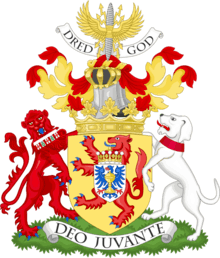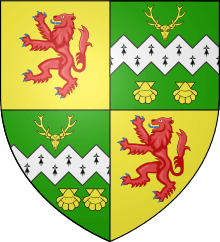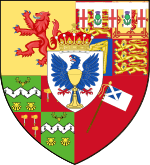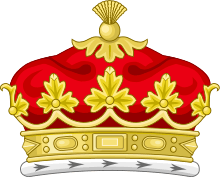Duke of Fife
| Dukedom of Fife | |
|---|---|
 Arms: Or, a Lion rampant Gules, armed and langued Azure (the Dukedom of Fife), and on an Inescutcheon Argent, ensigned of an Earl's Coronet proper, an Eagle displayed Azure, armed, beaked and membered Gules, and charged on its breast with an Antique Covered Cup Or (Carnegie). Crest: A Thunderbolt proper, winged Or, on a Scroll the words DRED GOD. Supporters: Dexter: a Lion guardant Gules, langued Azure, collared with a Label of five-points Argent, charged with two Thistles proper, between three Crosses of St George Gules. Sinister: a Talbot Argent, collared and langued Gules. | |
| Creation date | 24 April 1900 |
| Creation | Second |
| Monarch | Victoria |
| Peerage | Peerage of the United Kingdom |
| First holder | Alexander Duff, 6th Earl Fife |
| Present holder | David Carnegie, 4th Duke |
| Heir apparent | Charles Carnegie, Earl of Southesk |
| Remainder to | the 1st Duke's heirs male of the body lawfully begotten; the 1st Duke's daughters and heirs male of their bodies lawfully begotten |
| Subsidiary titles |
Earl of Southesk Earl of Macduff Lord Carnegie of Kinnard Lord Carnegie of Kinnard and Leuchards Baron Balinhard Baronet 'of Pitcarrow' |
| Seat(s) |
Elsick House Kinnaird |
| Former seat(s) | Mar Lodge |
| Armorial motto |
DEO JUVANTE (God helping) |
Duke of Fife is a title in the Peerage of the United Kingdom which has been created twice, in both cases for Alexander Duff, 6th Earl Fife, who in 1889 married Louise, Princess Royal, the eldest daughter of the future King Edward VII.
The dukedom of Fife was created for Queen Victoria's grandson-in-law, thus for a member of the British Royal Family, but was the last such creation for a person who was not a son, grandson or consort of the Sovereign.
History
Alexander Duff (1849–1912) was the eldest son of the 5th Earl Fife. Upon his father's death on 7 August 1879, he succeeded as 6th Earl Fife in the Peerage of Ireland and 2nd Baron Skene in the Peerage of the United Kingdom (only the latter title gave him a seat in the House of Lords). In 1885, Queen Victoria created him Earl of Fife in the Peerage of the United Kingdom.[1]
On Saturday, 27 July 1889, Lord Fife married Princess Louise, the third child and eldest daughter of the then-Prince of Wales (the future King Edward VII) and his wife Princess Alexandra, in the Private Chapel at Buckingham Palace. The couple were third cousins in descent from George III. The wedding marked the second time a descendant of Queen Victoria married a British subject (the first being the marriage of The Princess Louise, the Queen's fourth daughter, to the Marquess of Lorne).
Two days after the wedding, the Queen elevated Lord Fife to the further dignity of Duke of Fife and Marquess of Macduff, in the County of Banff, in the Peerage of the United Kingdom.[2] In the first creation of the dukedom of Fife, Queen Victoria's Letters Patent of 29 June 1889 contained the standard remainder to "heirs male of his body". Letters Patent of 24 April 1900 created a second dukedom of Fife with a special remainder that allowed the dukedom to pass to the daughters of the first Duke, in default of a son, and then to the male heirs of those daughters. The one restriction was that the mother of those daughters had to be the Princess Louise; daughters from any subsequent marriage could not inherit. On the same date and occasion, the Duke of Fife was also created Earl of Macduff, with similar remainder which allowed the earldom to pass to the daughters of the first Duke, in default of a son, and then to the male heirs of those daughters.
Upon the 1st Duke of Fife's death in 1912, the peerages created in 1889 and some older peerages held by the Duff family became extinct, while the peerages created in 1900 passed to the 1st Duke's elder daughter, Alexandra (1891–1959, née Lady Alexandra Duff). On 15 October 1913, she married Prince Arthur of Connaught, the only son of Prince Arthur, Duke of Connaught and Strathearn, third son of Queen Victoria and Prince Albert and thus a younger brother of her maternal grandfather King Edward VII. As such, Arthur and Alexandra were first cousins once removed. Their only son, Alastair, died in 1943.
When the 2nd Duchess of Fife died in 1959, her hereditary peerages passed to her nephew James Carnegie (1929-2015), eldest son of her sister Maud (née Lady Maud Duff) and her husband Charles Carnegie, 11th Earl of Southesk. Thirty-three years later, in 1992, the 3rd Duke of Fife also succeeded his father as 12th Earl of Southesk and chief of the Clan Carnegie. Upon his death in 2015, he was succeeded by his son, David, as fourth duke. The heir apparent of the titles is his son, Charles Carnegie, Earl of Southesk.
The family's current main residence is Elsick House near Stonehaven, The Mearns, within the watershed of the Burn of Elsick. The first two holders of the dukedom are buried in St Ninian's Chapel, Braemar.
Other titles
From 1790 until 1809 (extinct) and from 1827 until its extinction in 1857, the title of Baron Fife (GB / UK) was held by the Earl Fife. In 1735, the title of Baron Braco (I) was created for the later 1st Earl Fife.
The titles of Marquess of Macduff (created 1889), Earl Fife (1759), Earl of Fife (1885), Viscount Macduff (1759), Baron Braco (1735), and Baron Skene (1857) became extinct along with the first dukedom of Fife. The titles of Marquess of Macduff, Earl of Fife, and Baron Skene are in the Peerage of the United Kingdom, whereas all the others are in the Peerage of Ireland.
The subsidiary titles held by the present Duke are: Earl of Macduff (created 1900), Earl of Southesk (1633), Lord Carnegie of Kinnaird (1616), Lord Carnegie (1633), and Baron Balinhard (1869). The titles of Earl of Macduff and Baron Balinhard are in the Peerage of the United Kingdom, whereas all the others are in the Peerage of Scotland. All subsidiary titles other than that of Earl of Macduff have been subsidiary titles of the Earls of Southesk.
Seats
The duke's current seats are Elsick House, Kincardineshire and Kinnaird Castle, Brechin. Mar Lodge, Braemar was bequeathed by Princess Alexandra, 2nd Duchess of Fife to her nephew Alexander Ramsay of Mar, and subsequently sold.
Coat of arms
- Shield: Quarterly: 1st, Or a Lion rampant Gules armed and langued Azure (Dukedom of Fife); 2nd, the arms of the United Kingdom as borne by HM King Edward VII differenced by a Label of five points Argent the points charged with two Thistles between three Crosses of St George Gules (HRH The Princess Royal, Duchess of Fife); 3rd, grandquarterly: 1st and 4th, Vert a Fess dancetty Ermine between a Hart's Head cabossed in chief and two Escallops in base Or (Duff of Braco); 2nd and 3rd, Gules three Skeans paleways Argent hafted and pommelled Or surmounted by as many Wolves' Heads couped of the third (Skene of that Ilk); 4th, Gules a Banner displayed Argent charged with a Canton Azure a Saltire of the second (Bannerman of Elsick); over all ensigned of an Earl's Coronet proper an Inescutcheon Argent an Eagle displayed Azure armed beaked and membered Gules on its breast an Antique Covered Cup Or (Carnegie)
- Crests: Centre: a Thunderbolt proper winged Or (Carnegie); Dexter: a Knight denoting the ancient MacDuff armed at all points on a Horse in full speed in his dexter hand a Sword erect all proper his Jupon Argent on his sinister arm a Shield Or charged with a Lion rampant Gules the visor of his helmet shut over which on a Wreath of his liveries with a long Mantling flowing therefrom behind him and ending in a Tassel of the fourth doubling of the third is set a Lion rampant issuing out of a Wreath of the third and fourth the Caparisons of the horse Gules fimbriated Or and thereon six Shields of the last each charged with a Lion rampant of the fourth (Dukedom of Fife); Sinister: a Man in armour issuing from the loins and wearing a Tabard emblazoned of the arms Argent on a Fess between three Boars' Heads erased Gules three Mascles Or sustaining with his dexter hand a Banner developed Argent having a Canton Azure charged with a Saltire of the first (Ethel, Countess of Southesk)
- Supporters: Dexter: a Lion rampant guardant Gules langued Azure collared with a Label of five points Argent the points charged with two Thistles between three Crosses of St George Gules; Sinister: a Talbot Argent collared Gules the Collar charged with a Label of three points Argent
- Mottoes: Above the centre crest: Dred God; Above the dexter crest: Deo Juvante; Above the sinister crest: Pro Patria; Beneath the shield: Virtute Et Opera
Duke of Fife (1889)
.jpg)
| Created by Queen Victoria | ||||||
|---|---|---|---|---|---|---|
| # | Name | Period | Spouse | Notes | Other titles | |
| 1 | Alexander William George Duff (1849–1912) | 1889–1912 | Louise, Princess Royal | Grandson-in-law of Queen Victoria | Marquess of Macduff, Earl Fife, Viscount Macduff, Baron Braco, Baron Skene | |
Dukes of Fife (1900)
| Created by Queen Victoria | ||||||
|---|---|---|---|---|---|---|
| # | Name | Period | Spouse | Notes | Other titles | Coat of Arms |
| 1 | Alexander William George Duff (1849–1912) | 1900–1912 | Louise, Princess Royal | Grandson-in-law of Queen Victoria | Marquess of Macduff, Earl Fife, Viscount Macduff, Baron Braco, Baron Skene |  |
| 2 | Princess Alexandra Victoria Alberta Edwina Louise (1891–1959) | 1912–1959 | Prince Arthur of Connaught | Granddaughter of King Edward VII and daughter of the 1st Duke | Countess of Macduff |  |
| 3 | James George Alexander Bannerman Carnegie (1929-2015) | 1959–2015 | The Hon. Caroline Dewar divorced | Nephew of the 2nd Duchess | Earl of Southesk, Earl of Macduff, Lord Carnegie of Kinnaird, Lord Carnegie of Kinnaird and Leuchars, Baron Balinhard, Baronet 'of PitCarrow' |  |
| 4 | David Charles Carnegie (born 1961) | from 2015 | Caroline Anne Bunting | Only surviving son of the 3rd Duke |  | |
Line of succession
- Charles Duff Carnegie, Earl of Southesk (born 1989), eldest son of the 4th Duke
- Lord George Carnegie (born 1991), second son
- Lord Hugh Alexander Carnegie (born 1993), third and youngest son
Family tree
| HM Queen Victoria (1819–r.1837–1901) | |||||||||||||||||||||||||||||||||||||
| Earl Fife | |||||||||||||||||||||||||||||||||||||
| HM King Edward VII (1841–r.1901–1910) | HRH Prince Arthur, 1st Duke of Connaught and Strathearn (1850–1942) | James Duff, 5th Earl Fife (1814–1879) | |||||||||||||||||||||||||||||||||||
| Earl of Fife, 1885 DUKE OF FIFE, 1889·1900 | |||||||||||||||||||||||||||||||||||||
| HM King George V (1865–r.1910–1936) | HRH Louise, Princess Royal, Duchess of Fife (1867–1931) | Alexander Duff, 6th Earl Fife, 1st Earl of Fife, 1st Duke of Fife (1849–1912) | |||||||||||||||||||||||||||||||||||
| Earl of Southesk | |||||||||||||||||||||||||||||||||||||
| Prince Arthur of Connaught (1883–1938) | Princess Alexandra, 2nd Duchess of Fife (1891–1959) | Princess Maud, Countess of Southesk (1893–1945) | Charles Carnegie, 11th Earl of Southesk[3] (1893–1992) | ||||||||||||||||||||||||||||||||||
| Prince Alastair Arthur, 2nd Duke of Connaught and Strathearn (1914–1943) | James Carnegie, 3rd Duke of Fife, 12th Earl of Southesk[3] (1929-2015) | ||||||||||||||||||||||||||||||||||||
| David Carnegie, 4th Duke of Fife (b. 1961) | |||||||||||||||||||||||||||||||||||||
| Charles Carnegie, Earl of Southesk (b. 1989) | Lord George Carnegie (b. 1991) | Lord Hugh Carnegie (b. 1993) | |||||||||||||||||||||||||||||||||||
References
- ↑ "No. 25490". The London Gazette. 14 July 1885. p. 3239.
- ↑ "No. 25958". The London Gazette. 27 July 1889. p. 4077.
- 1 2 Some references list the 11th and 12th Earls of Southesk as the 8th and 9th Earls of Southesk because of the attainder on the titles of 1715 which was not reversed until 1855.
